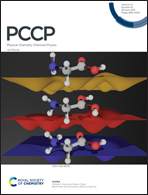Tuning the reduction potentials of benzoquinone through the coordination to Lewis acids†
Abstract
Electron transfer promoted by the coordination of a substrate molecule to a Lewis acid or hydrogen bonding group is a critical step in many biological and catalytic transformations. This computational study investigates the nature of the interaction between benzoquinone and one and two Lewis acids by examining the influence of Lewis acid strength on the ability to alter the two reduction potentials of the coordinated benzoquinone molecule. To investigate this interaction, the coordination of the neutral (Q), singly reduced ([Q]˙−), and doubly reduced benzoquinone ([Q]2−) molecule to eight Lewis acids was analyzed. Coordination of benzoquinone to a Lewis acid became more favorable by 25 kcal mol−1 with each reduction of the benzoquinone fragment. Coordination of benzoquinone to a Lewis acid also shifted each of the reduction potentials of the coordinated benzoquinone anodically by 0.50 to 1.5 V, depending on the strength of the Lewis acid, with stronger Lewis acids exhibiting a larger effect on the reduction potential. Coordination of a second Lewis acid further altered each of the reduction potentials by an additional 0.70 to 1.6 V. Replacing one of the Lewis acids with a proton resulted in the ability to modify the pKa of the protonated Lewis acid–Q/[Q]˙−/[Q]2− adducts by about 10 pKa units, in addition to being able to alter the ability to transfer a hydrogen atom by 10 kcal mol−1, and the capacity to transfer a hydride by about 30 kcal mol−1.



 Please wait while we load your content...
Please wait while we load your content...